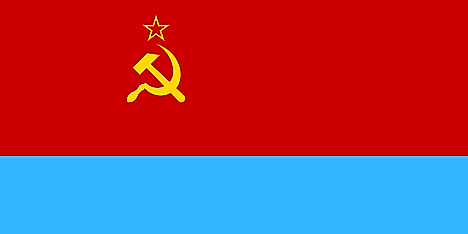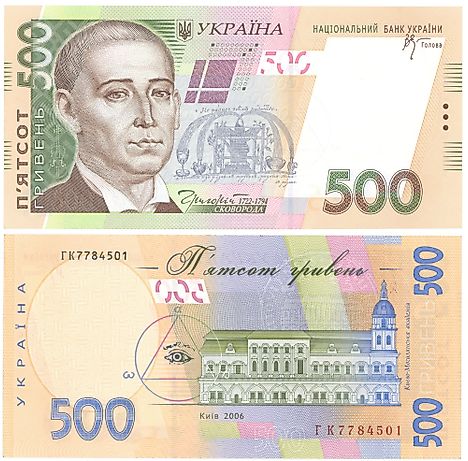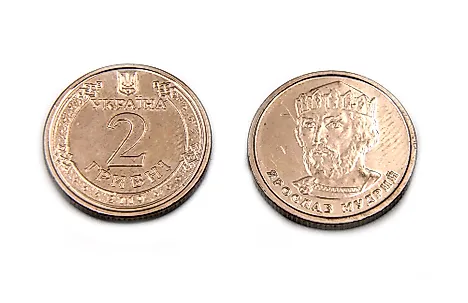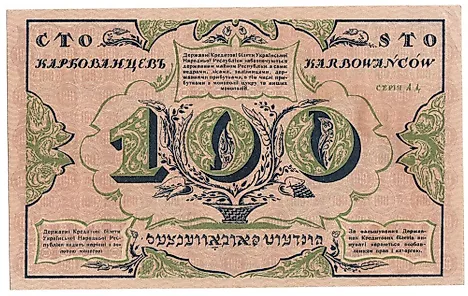Flags, Symbols & Currency of Ukraine
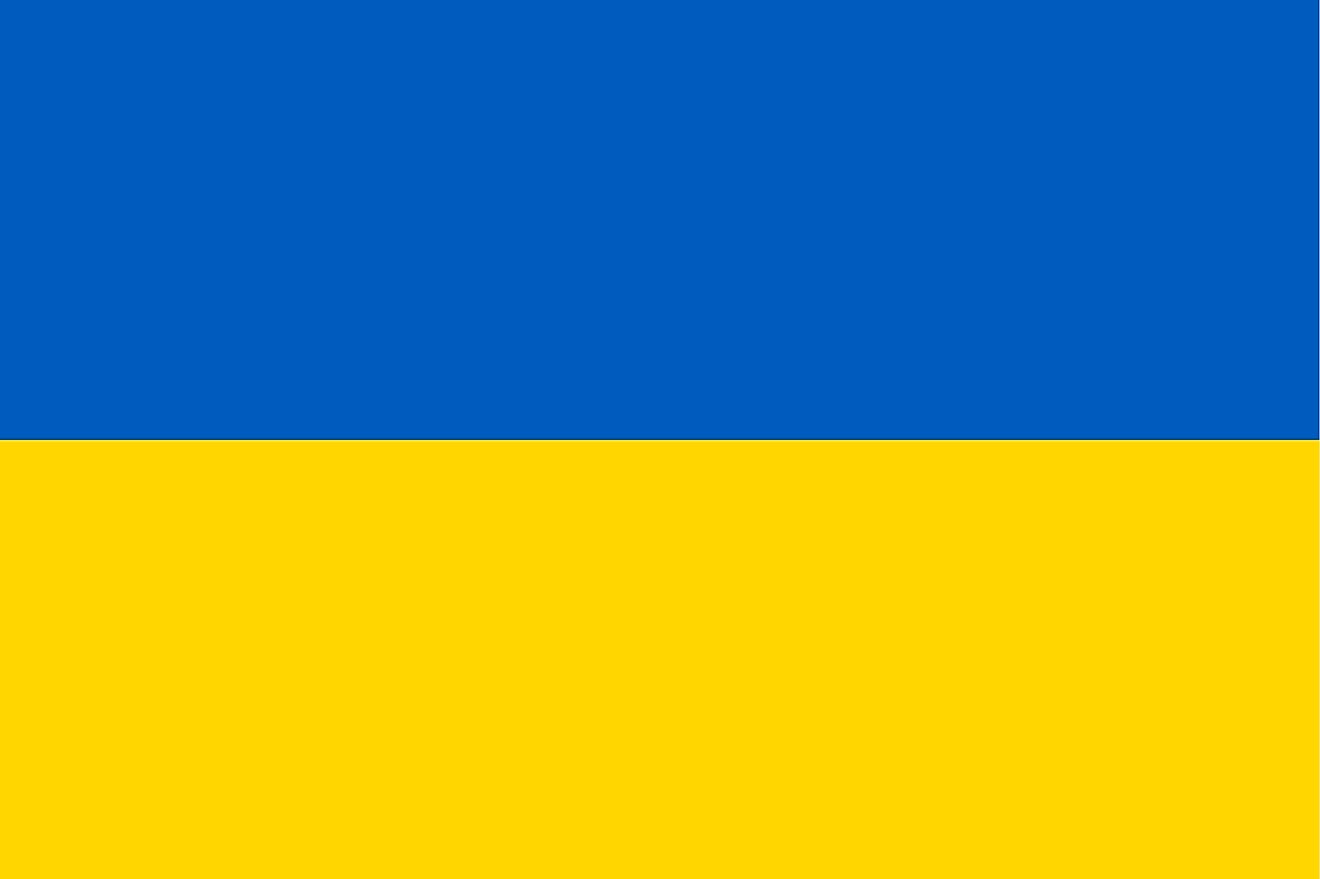
The National Flag of Ukraine was officially adopted on January 28, 1992.
The National Flag of Ukraine features two equal horizontal bands of azure/blue (top) and golden yellow. The blue color of the flag represents the sky, streams, and mountains of Ukraine. The yellow color symbolizes Ukraine's golden wheat fields and the richness of the earth. The flag has a height-to-width proportion ratio of 2:3.
History of the Flag of Ukraine
The two-official flag colors (blue and yellow) are based on the flag of the 12th century Kingdom of Galicia–Volhynia. The two colors have been used on the national flag of Ukraine since 1848 when the revolutionaries managed to take power for a brief period. Though this revolution failed, the flag remained as a potent Ukrainian nationalist symbol. Ukraine again achieved independence in 1917, and the old flag colors of the revolutionaries were officially adopted for the nation’s flag in 1918 by the West-Ukrainian People’s Republic and subsequently by the Ukrainian People’s Republic. This flag too was short-lived, as, after a few years, a communist government took power and adopted a new flag. The old flag was outlawed and was not reinstated until 1991, although it was on a provisional basis. On January 28, 1992, the Parliament of Ukraine officially restored the blue-yellow flag.
Symbols of Ukraine
The National Coat of Arms of Ukraine

The National Coat of Arms of Ukraine (small coat of arms) was officially adopted on February 19, 1992. It consists of a blue shield with a golden border. Within the shield is placed a golden trident (commonly referred to as the Tryzub). The trident dates back to the 11th century when it was the symbol of the Princely State of Volodymyr the Great (980-1015).
National Anthem
- Anthem Title: "Shche ne Vmerla Ukrainy ni Slava, ni volia" ("State Anthem of Ukraine" )
- Music Composer: Mykhailo Verbytskyi
- Lyricist: Pavlo Chubynskyi
- Date of Adoption: March 6, 2003
"Shche ne Vmerla Ukrainy ni Slava, ni volia" ("State Anthem of Ukraine" ) is the national anthem of Ukraine. The music of the anthem have been composed by Mykhailo Verbytskyi. The lyrics of the anthem have been authored by Pavlo Chubynskyi. The anthem was officially adopted on March 6, 2003.
«Ще не вмерла України ні слава, ні воля» (Ukranian)
Ще не вмерла України і слава, і воля,
Ще нам, браття молодії, усміхнеться доля.
Згинуть наші воріженьки, як роса на сонці.
Запануєм і ми, браття, у своїй сторонці.
Chorus:
Душу й тіло ми положим за нашу свободу,
І покажем, що ми, браття, козацького роду
Душу й тіло ми положим за нашу свободу,
І покажем, що ми, браття, козацького роду
Ukraine’s glory hasn’t perished, nor her freedom
Upon us, fellow compatriots, fate shall smile once more.
Our enemies will vanish, like dew in the morning sun,
And we too shall rule, brothers, in a free land of our own.
Chorus:
We’ll lay down our souls and bodies to attain our freedom,
And we’ll show that we, brothers, are of the Kozak nation.
We’ll lay down our souls and bodies to attain our freedom,
And we’ll show that we, brothers, are of the Kozak nation.
The Currency of Ukraine is the Ukrainian hryvnia
The current official currency of Ukraine is Ukrainian hryvnia (sign: ₴, code: UAH). It was introduced on September 2nd, 1996, and is subdivided into 100 kopiyka (cents). The currency has been named after the weight measures used during the medieval Kievan Rus’ period. The National Bank of Ukraine is responsible for the production, circulation, and stability of the hryvnia.
Coins
The hryvnia coins were minted in 1992 but were not released into circulation until September 1996 due to hyperinflation and instead coins valued between 1 and 50 kopecks were being circulated. The one hryvnia-coin was introduced in March 1997. The National Bank of Ukraine declared that it would produce the two hryvnia-coins in October 2012. In 2013, the production of the 1- and 2-kopek coins was halted due to high production costs. As of 2016, there were about 12.4 billion coins worth 1.4 billion hryvnias.
Currently, 10, 50 kopiyoks and 1, 2, 5, 10 ₴ coins are in circulation.
Banknotes
The National Bank of Ukraine introduced the first series of the hryvnia banknotes in 1996 with the denominations of 1, 2, 5, 10, and 20 hryvnias. They were printed by the Canadian Bank Note Company in 1992 but were not circulated just like coins. The 50 and 100 hryvnia notes were also printed but were not distributed. In 1994 British company De La Rue printed the second series of the 1-, 50-, and 100-hryvnia notes, the 200-hryvnia note was introduced in 2001, followed by the 500-hryvnia note in 2006. The 2-hryvnia note is preferred by many compared to the 2-hryvnia coin. The 100- and 200-hryvnia notes are the most common, and most Ukrainian ATMs dispense these notes. In 2016, the National Bank of Ukraine began producing a newer version of notes made of flax instead of cotton.
Currently, 1, 2, 5, 10, 20, 50, 100, 200, 500 and 1000₴ banknotes are in circulation.
Historical currencies of Ukraine
After the Ukrainian National Republic separated from the Russian empire in 1917, it replaced its currency from the hryvna to the hryvnia. The currency was designed by Heorhiy Narbut. In the same year, it replaced the hryvnia with the first series of Karbovanets (the Ukrainian cupon). In 1992, Ukraine adopted its third series of the Karbovanets, but it was subjected to hyperinflation after the collapse of the USSR. In September 1996, the hryvnia was introduced to replace the Karbovanets at a rate of 1 hryvnia = 100,000 karbovantsiv. The introduction of the hryvnia was secretive and ordered by a President's Decree on August 29th, 1996. Both currencies were used during the transition period between September 2–16, but banks and monetary merchants were instructed to issue the hryvnia only. In the first five days, 97% of the Karbovanets had been removed from circulation while the public was allowed to exchange the remaining in the banks. After Russia annexed Crimea on March 18th, 2014, the annexed state declared that it would no longer use the Ukrainian hryvnia as its currency and instead adopted the Russian ruble.

